I have a Details table which can be described by the following:
Create table #Details (
Id int identity,
HeaderId int,
ChannelId int,
Value float
)
We insert some seed data:
insert into #Details (HeaderId, ChannelId, Value) values(1, 0, 1019.51)
insert into #Details (HeaderId, ChannelId, Value) values(1, 1, 20.1)
insert into #Details (HeaderId, ChannelId, Value) values(1, 2, 21.2)
insert into #Details (HeaderId, ChannelId, Value) values(1, 3, 22.3)
insert into #Details (HeaderId, ChannelId, Value) values(1, 4, 23.4)
insert into #Details (HeaderId, ChannelId, Value) values(2, 0, 1020.62)
insert into #Details (HeaderId, ChannelId, Value) values(2, 1, 26.1)
insert into #Details (HeaderId, ChannelId, Value) values(2, 2, 27.2)
insert into #Details (HeaderId, ChannelId, Value) values(2, 3, 28.3)
insert into #Details (HeaderId, ChannelId, Value) values(2, 4, 29.4)
Select All produces the following:
I would like to transpose the column data to rows, to produce the output below:
Thanks in advance.


